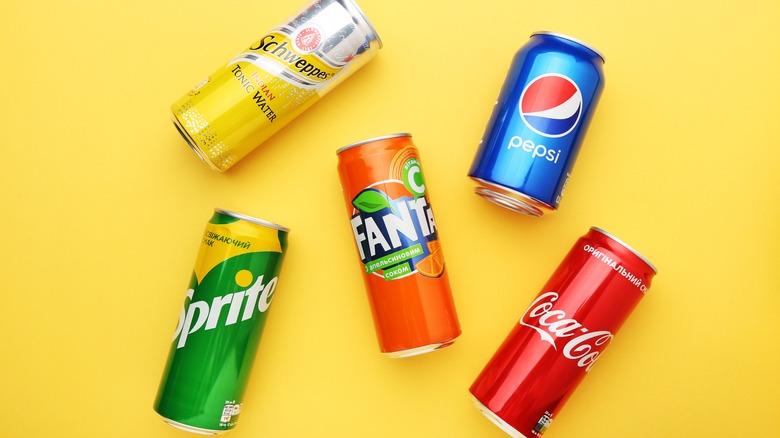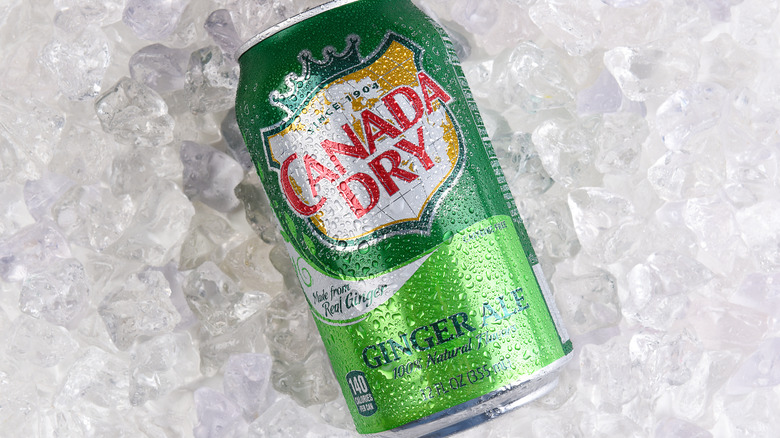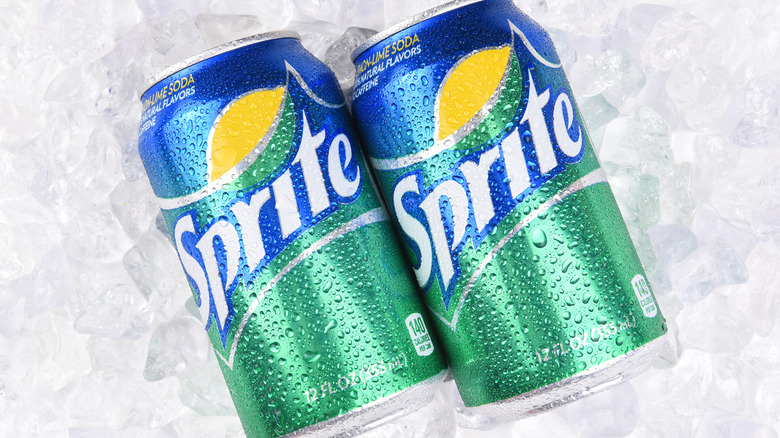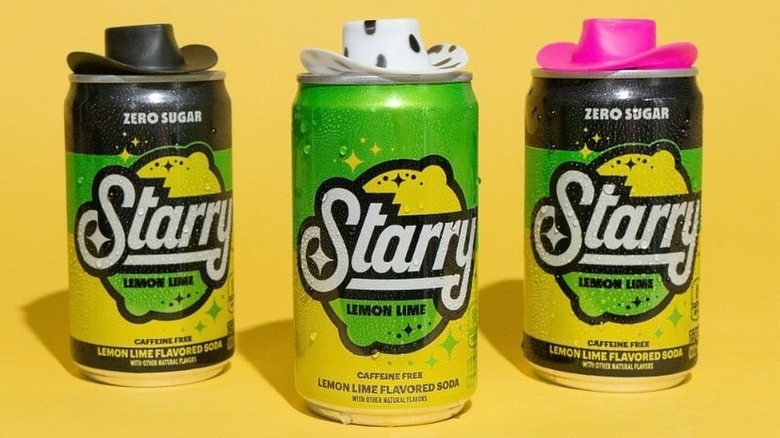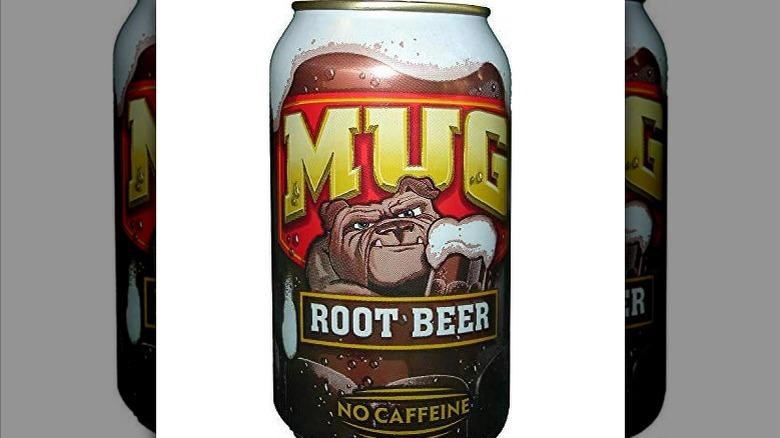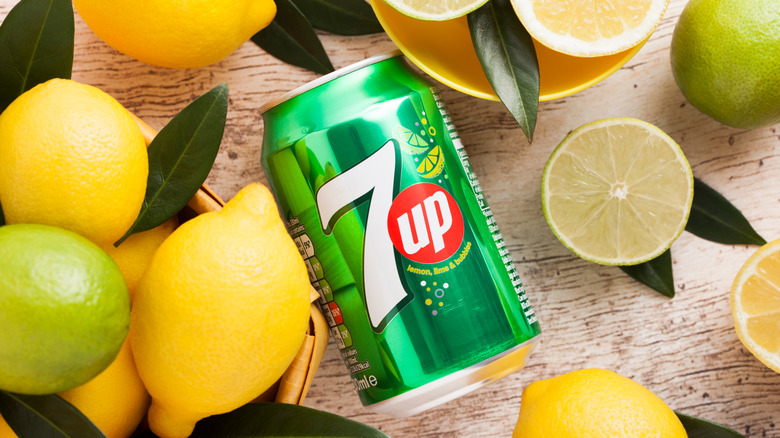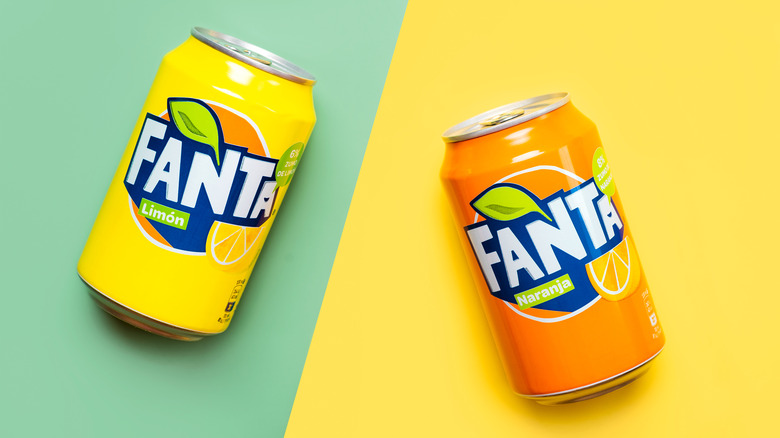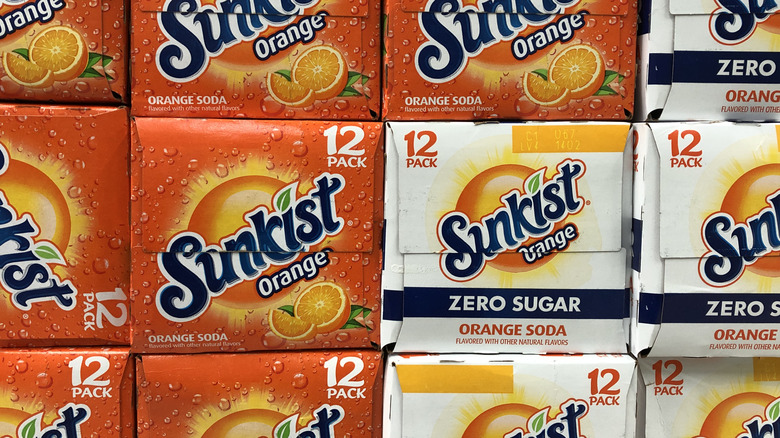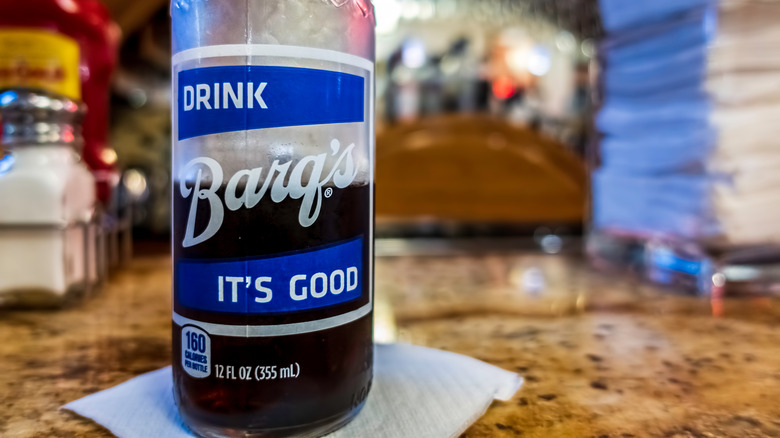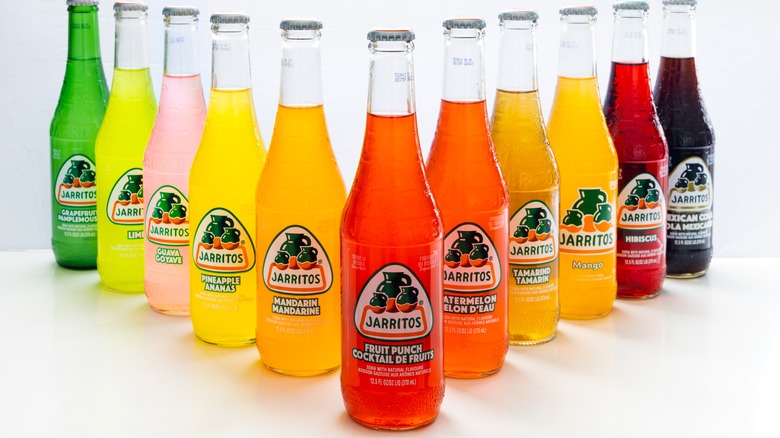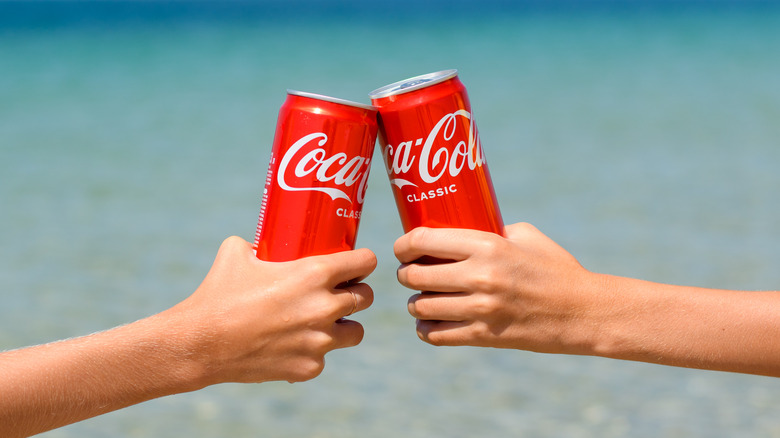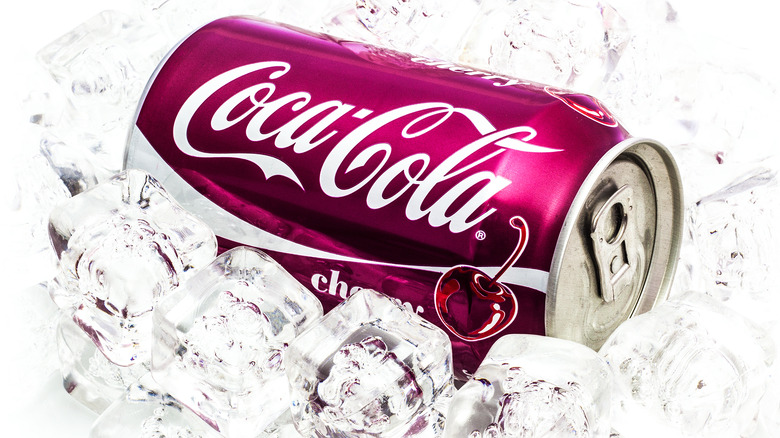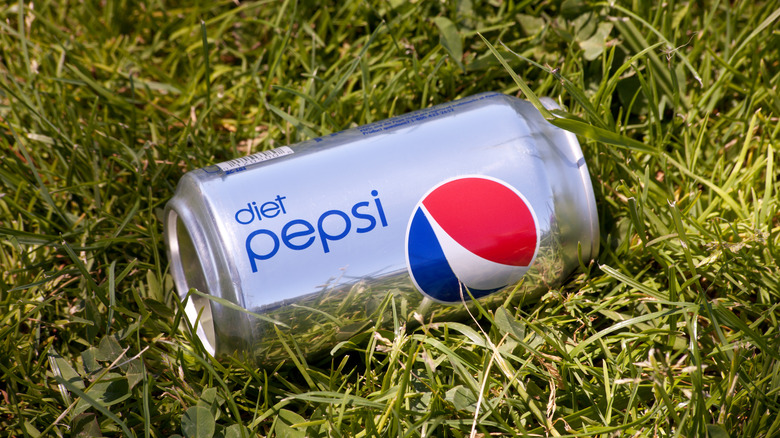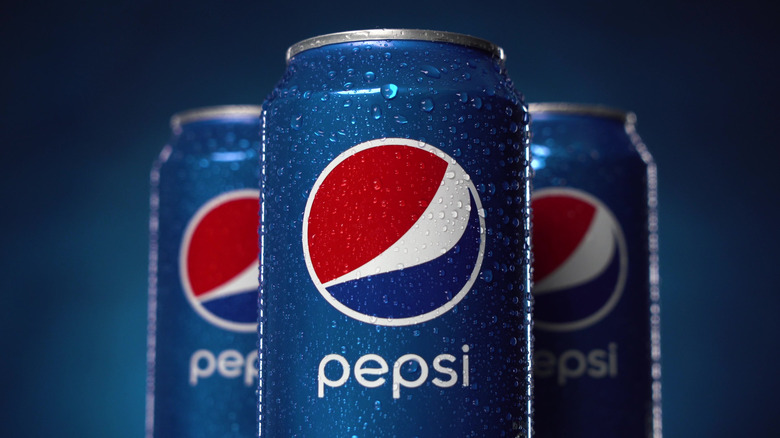The Caffeine Content Of 24 Popular Sodas, Ranked Lowest To Highest
Caffeine: according to statistics, it's the thing that keeps a lot of countries running. Statista data shows that in 2022, 74% of Americans reported drinking coffee every day. It makes sense, considering the fact that caffeine stimulates your mental and nervous system activity, all while delivering energy to a very sleep-deprived world so people can get through their day.
However, caffeine isn't just found in your favorite Starbucks order, energy drink, or chocolate bar. Plenty of your favorite sodas have it as well, though perhaps surprisingly, not all of them do, including a couple of the most popular brands.
It's good to know which sodas may inadvertently be keeping you awake and which you can enjoy right after your coffee with no side effects whatsoever. The caffeine content of the sodas is measured in milligrams per serving of 12 fluid ounces. Keep in mind that a regular cup of coffee — a standard coffee shop tall order is 12 fluid ounces — has around 144 milligrams of caffeine per serving, meaning it will usually pack a much bigger boost of energy than your average soda.
Canada Dry Ginger Ale - 0 milligrams
One of the many reasons ginger ale is considered a somewhat healthier soda option is the fact that zero caffeine is found in Canada Dry Ginger Ale. Prefer Schweppes or another ginger ale brand? The caffeine content is likely to be exactly the same: none.
Many people drink ginger ale to settle an upset stomach; it's good to know this home remedy won't keep them up at night. However, the idea that ginger ale relieves nausea is mostly a myth. Though ginger root helps, the amount in soda is so little that it won't do much for stomach problems. On the plus side, ginger ale is a great mixer for a slew of drinks, so it's useful to have around the house.
Sprite - 0 milligrams
Another big surprise is that the extremely popular brand Sprite actually has no caffeine. Produced under the umbrella of the Coca-Cola company, the green-bottled Sprite is a lighter-tasting beverage with natural lemon and lime flavors that refresh drinkers. So what does this soda actually include, if not caffeine? Carbonated water, sugar, citric acid, and sweeteners, including aspartame, in addition to the aforementioned flavors.
Because of the lighter taste, people also believe Sprite has less sugar or calories than Coca-Cola, but that's not true. Both have 140 calories per can, and Sprite has 38 added grams. You might consider picking Sprite for the flavor instead of any perceived health benefits. Today, you can find this crisp, slightly sweet soda in over 190 countries around the world.
Starry/Sierra Mist - 0 milligrams
PepsiCo recently decided to reconfigure one of its brands, retiring Sierra Mist and launching a new lemon-lime soda. With a few tweaks to the recipe, they have renamed and released Sierra Mist as Starry. For those who want a light carbonated beverage without a caffeine high, the good news is that Starry, like Sierra Mist, is a caffeine-free soda.
The differences between Starry and Sierra Mist aren't stark. PepsiCo had to retire Sierra Mist because sales of the product were way behind their main competitor, The Coca-Cola Company's Sprite. Starry is still a lemon-lime-flavored soda, with a little more citric acid added to produce a tangier flavor and a more distinct, enticing smell. The new brand's logo is "Starry Hits Different", and that's certainly what PepsiCo hopes will happen with consumers.
Mug Root Beer - 0 milligrams
Like many other brands of root beer, Mug Root Beer has no caffeine, so customers can enjoy the soda's thick, creamy flavor without getting a little more stimulated than they expected. Since root beer was initially conceived as an alternative to regular beer, many people love to pair root beer with grilled or smoked meats, including classic BBQ food such as burgers and briskets. You can even use Mug Root Beer to make a classic root beer float.
Mug Root Beer prides itself on using natural ingredients and no animal by-products. This focus on creating a natural, caffeine-free beverage makes it a great choice for those seeking to cut back on caffeinated sodas.
7Up - 0 milligrams
7Up, or Seven Up, depending on your preference, is often considered a close alternative to Sprite. However, soda drinkers have disagreed for decades over which brand is better. Some people say 7Up is less syrupy and sweet than Sprite, while others don't even taste a difference. One thing is for sure: the soda brands are very similar in their caffeine content. 7UP is caffeine-free. Also, sorry to Sprite fans, but 7Up was here first, as the brand was first sold in 1929.
When Charles Leiper Grigg first launched 7Up, it was named "Bib-Label Lithiated Lemon-Lime Soda" — not the catchiest of names. However, the original formula for the popular lemon-lime soda contained the compound lithium citrate, which made its drinkers feel cheery — until the U.S. government banned lithium in drinks in 1948.
Fanta - 0 milligrams
Fanta is one of the most popular brands of soda internationally. Sold everywhere in Europe and Latin America and is the second most popular beverage in Africa, trailing only Coca-Cola. However, no matter where it's sold, the caffeine content is the same, clocking in at a total of 0 milligrams.
In the U.S., the Coca-Cola company that distributes Fanta didn't initially want this internationally popular drink to undermine Coke. The company stopped distributing Fanta throughout the country from the mid-1980s to 2001, during which it was only available in larger urban markets. When Fanta was re-introduced nationally in the U.S., the Coca-Cola company supported it with a strong marketing campaign that eventually placed the drink in the top 10 sodas nationwide.
Sunkist (Regular and Diet) - 19 milligrams
The true caffeine count starts with Sunkist Orange, which contains 19 milligrams of caffeine per 12 fluid ounces. It is, therefore, the least of the caffeinated sodas on our list. The caffeine content is the same for the regular and diet versions of the soda, even the zero-sugar options. Sunkist is an orange soda, but it has a distinctive tangy taste and less carbonation than Fanta.
If you're not the biggest fan of classic orange sodas, don't worry, as there are actually several fruit flavor varieties of Sunkist available. Recently, the company introduced cans of mango orange, berry lemonade, strawberry lemonade, and alternate soda flavors like grape and peach.
Barq's Root Beer - 22 milligrams
Not all root beer goes the caffeine-free route; Barq's Root Beer contains a surprising 22 milligrams of caffeine per can, making it an outlier among root beer brands in the United States. Since caffeine does not naturally occur in most root beer ingredients, Barq's goes out of its way to add caffeine. Though some customers dislike this and prefer Barq's caffeine-free brands, like Diet Root Beer and Red Creme Soda, others credit the caffeine and added sugars in Barq's with creating a bolder, more energizing drink.
The added sugars are high, even when compared with prominent soda brands like Pepsi and Coca-Cola. Barq's has 44 grams of added sugars in each can of root beer, which may help explain the calorie count of 160 calories per serving.
Jarritos - 32 milligrams
Known for the variety of strong, fruity flavors it comes in, Jarritos is a Mexican soda that has become an increasingly popular beverage choice in the U.S. It first reached the U.S. market in 1988, when it quickly became one of the top-selling beverages in Hispanic neighborhoods. Each serving of Jarritos contains 32 milligrams of caffeine in 12.5 fluid ounces, slightly bigger than the standard 12-ounce servings.
The name of the drink means "little jugs" in Spanish. The colorful Jarritos sodas are based on aguas frescas, refreshing drinks traditionally made of fresh fruits, sweeteners, water, and a couple of herbs for good measure. You can tell the flavor of most Jarritos bottles by their distinctive color. The assortment of popular Jarritos flavors includes guava, lime, pineapple, strawberry, and mandarin, among others.
Coca-Cola Classic (and Zero) - 34 milligrams
With its instantly recognizable red can and white logo, original Coca-Cola has dominated the international soda market for years. Both the Classic and Zero versions of the beverage contain 34 milligrams of caffeine per 12 fluid ounces, surprisingly putting it in the lower range for most caffeinated sodas.
While the recipe for Coca-Cola is famously tightly guarded, many drinkers believe notes of cinnamon and vanilla contribute to the drink's unique, sweet, and slightly syrupy taste. The taste of Coke also differs between the U.S., which uses high fructose corn syrup, and Europe and Mexico, which mostly use cane sugar. No matter what your feelings on Coke are, there's no denying that it has become one of the most enduring and powerful brands in the world overall.
Cherry Coke - 34 milligrams
In its debut year of 1985, the introduction of a cherry soda to the beverage market may have seemed like an odd choice, but there was quite a bit of precedent for such a move. In earlier decades, customers at soda fountains commonly requested a pump of cherry syrup into their soda, usually Coca-Cola.
As the name suggests, Cherry Coke has a unique take on the original Coca-Cola recipe. Grown beyond a niche soda, some people even prefer it over regular Coke. However, whatever changes the company implements to the flavor don't seem to affect the caffeine content. Cherry Coke has 34 milligrams of caffeine, exactly the same as an original can. Note that this flavor of Coke does contain around 42 grams of added sugars, which is over 80% of a person's recommended daily intake.
Diet Pepsi - 35 milligrams
Diet Pepsi contains 35 milligrams of caffeine per 12-ounce can. The good news is Diet Pepsi definitely lives up to its name. The drink contains zero grams of sugar and zero calories overall, making it a great choice for calorie-conscious soda drinkers. However, like most sodas, doctors recommend indulging in it only occasionally as the artificial sweeteners and ingredients added in, including aspartame, are not the most nutritious choice.
Diet Pepsi was launched in 1964 after being tested under the brand name "Patio," making it the first low or no-calorie soda distributed in the U.S. "Patio" was chosen as PepsiCo wasn't sure if diet drinks would prove popular. Luckily for the company, it was absolutely wrong about the popularity of diet sodas. Today, Diet Pepsi is available all throughout the country, as well as most of the world.
Pepsi - 37.5 milligrams
Pepsi may be one of the reasons that people connect drinking sodas to curing indigestion or an upset stomach. I North Carolina druggist Caleb Davis Bradham in 1893. However, he eventually renamed it Pepsi Cola because he thought the fizzy beverage would help with indigestion, otherwise known as dyspepsia.
The regular version of Pepsi has just a couple more milligrams of caffeine than the diet version, with 37.5 milligrams per serving. While the Pepsi vs. Coke debate may never be truly solved, blind taste tests have repeatedly found that users prefer Pepsi's taste.Some believe that the true decisive difference between Coke and Pepsi is citric acid. Coca-Cola has none, preferring to use phosphoric acid instead, while Pepsi has a fair amount, giving it a tart flavor.
Pepsi Zero Sugar - 38 milligrams
Until 2023, Pepsi Zero Sugar topped the list of caffeinated sodas at 69 milligrams a serving. Sold under the name Pepsi Max until 2016, this version of Pepsi sounds like it will jolt you awake; however, a regular, 12-fluid-ounce cup of coffee contains about 140 milligrams of caffeine. In comparison, the sodas you drink, including popular zero-sugar sodas like Pepsi Zero Sugar, are in little danger of keeping you up at night.
In 2023, Pepsi announced it was decreasing the caffeine in its Zero Sugar product. Thanks to a new sweetener system PepsiCo claims to use, the caffeine in Zero Sugar has been reduced to approximately that of a normal can of Pepsi — around 38 milligrams per 12-ounce serving.
Pibb Xtra - 40 milligrams
A resurrection of the original Mr. PiBB drink released in 1972, Pibb Xtra has a unique spicy cherry flavor that some customers love. The updated version tastes as if it contains an extra boost of cinnamon, among other small recipe changes. Fans even once started a petition to bring back the original flavor. (So far, the document has 237 signatures on Change.org.)
You may have some trouble finding Pibb Xtra these days, not because it's being discontinued but because the pandemic caused a shortage of aluminum cans, which led the Coca-Cola company to deprioritize more niche beverages. However, you can still likely find them at major supermarkets or retailers in your area. This beverage contains 40 milligrams of caffeine, as well as 140 calories.
Dr. Pepper (regular and diet) - 41 milligrams
Having been originally established in 1885, Dr. Pepper is one of the oldest sodas in the United States. The sweet, spiced cherry and vanilla notes make for an interesting yet polarizing flavor combination.
Perhaps because it has been around so long and felt the need to reinvent, Dr. Pepper comes in a variety of flavors, including cream soda, cherry, and cherry vanilla. However, both the regular and diet versions of Dr. Pepper are consistent in that they have 41 milligrams of caffeine per serving. As for the actual original recipe? It's split into two sections, each held in a different bank vault in Dallas, so no one actually knows the whole formula.
RC Cola - 43 milligrams
Though you may not know much about Royal Crown Cola, otherwise known as RC Cola, the brand has a presence in over 67 countries across six continents. It has been established in the United States since 1905 and has long been associated with the South since its inception in a family grocery store in Columbus, Georgia. The company takes pride in still using real cane sugar in its sodas, as opposed to high fructose corn syrup.
Each can of RC Cola contains 43 milligrams of caffeine. For those who dislike too much carbonation, the relatively flat RC Cola may be a good soda choice, as it tends to be less fizzy than a lot of other brands on the market.
Zevia Cola - 45 milligrams
You may think drinking soda means ingesting a lot of artificial flavors and colorings, but Zevia Cola aims to change that perception. Each can of Zevia Cola has 45 milligrams of caffeine, as well as no sugar, calories, or added colors. In addition, Zevia excludes GMO products from its recipes, preferring to use organic ingredients for citrus and spice flavors.
The one ingredient that may raise an eyebrow is the highly purified stevia the company uses to sweeten the soda, though some prefer the lack of calories and modified taste. Stevia is classified as a natural sweetener, and Zevia prides itself on avoiding artificial ingredients. Flavors come in ginger root beer, cherry cola, or caffeine-free cola options as well.
Diet Coke - 46 milligrams
The diet version of Coca-Cola has over 10 milligrams more caffeine flowing through it than the regular version at 46 milligrams per serving. The reason Diet Coke is lower in calories than regular Coke is less sugar, which changes the flavor profile of the drink. Though the Coca-Cola company has never made an official statement on why the caffeine content of its diet drinks is higher than its regular sodas, many consumers believe that the extra caffeine is used to improve the taste and strength of Diet Coke.
Diet Coke uses an entirely different recipe than regular Coca-Cola; the company aimed to create a different soda rather than just a low-calorie version of Coke. Shockingly, since the drink contains sweeteners but no real sugar, it can make you crave sugary foods and beverages, ultimately working against its stated purpose.
Cheerwine - 47 milligrams
Though Cheerwine's appearance (and even flavor) may be somewhat reminiscent of Dr. Pepper, it actually has a slightly higher caffeine content than the well-known soft drink, with a total of 47 milligrams of caffeine per 12-ounce can. The soda has a cherry-like taste and burgundy hue, as well as plenty of carbonation to give it that classic soft drink fizziness.
Produced by Carolina Beverage Corp. in North Carolina, Cheerwine has been around since 1917, though it wasn't trademarked until well into the 1920s. It was (and continues to be) a family-run operation. The soft drink's website proudly states that Cheerwine is "the oldest continuing soft drink company still operated by the same family", as it has been passed through five generations from the original founders to the present-day company executives.
Mello Yello - 51 milligrams
Originally developed as a potential competitor for Mountain Dew, Mello Yello has slightly less of a kick with 51 milligrams of caffeine per 12-ounce can — though that's still a whopping amount of caffeine. Developed by The Coca-Cola Company in 1979, Mello Yello was originally a regional product mostly available in the Southern U.S.
After a while, it expanded to stores nationwide; however, the expansion was recently somewhat reversed, and now Mello Yello is mostly sold in the eastern part of the country. It is still available as a fountain drink in plenty of chains, including Arby's and Cracker Barrel. In terms of flavor, this refreshing, citrus-flavored beverage has more of a fruity, orange juice-like taste, rather than the usual lemon and lime combinations found in citrus soda drinks.
Mountain Dew (regular and diet) - 54 milligrams
The classic green Mountain Dew has 54 milligrams of caffeine per can, as well as 170 calories and a whopping 46 grams of added sugars. For those who haven't had the famous soda, it has a saccharine, citrusy, and slightly tangy taste. Interestingly enough, though the name Mountain Dew may call to mind the magnificent outdoors, it was originally a reference to moonshine. Mountain Dew was first invented as a mixer for bourbon by brothers Ally and Barney Hartman.
In fact, the original Mountain Dew bottle design included a barefoot Appalachian man. A big change in branding was done over time to associate the drink with a young, active, city-dwelling crowd, moving away from the drink's Tennessee origins. It worked, as Mountain Dew has almost 7% of the U.S. market share today, according to Statista.
Mountain Zevia - 55 milligrams
The crisp, refreshing taste of Mountain Zevia disguises the fact that this soft drink has a fair amount of caffeine in it — 55 milligrams per serving. As with Zevia Cola, Mountain Zevia has no additional sugars or flavors, though it also relies on stevia extract for sweetness. The citrus flavor of the soda calls to mind a bolder version of Sprite.
The initial bright flavor of the drink is followed by an aftertaste that some people love, and others dislike; if you fall in the latter camp, try drinking this soda over ice, which can cut down the strength of the stevia. You'll usually find Mountain Zevia in health-conscious supermarket chains. People with dietary restrictions and preferences should know that Mountain Zevia is vegan and gluten-free.
Sun Drop - 64 milligrams
This citrus-flavored soft drink packs a punch; with 64 milligrams of caffeine per 12-ounce can, it's one of the most highly caffeinated beverages you can buy. A subsidiary of Keurig Dr. Pepper, Sun Drop Citrus Soda mixes carbonated water with orange juice and caffeine for a refreshing drink that will also wake you up.
Though the name Sun Drop has been around since 1928, when Charles Lazier of St. Louis created the citrus-flavored drink, he didn't fully bring the brand to the wider U.S. market until 1949. It ended up becoming immensely popular in the South, thanks to endorsements from regional icons like NASCAR driver Dale Earnhardt – and as a way to cool down during the hot and humid Southern summers.
Keep in mind that this caffeine content only applies to the regular version of Sun Drop. The diet version of this drink has an even higher caffeine content, clocking in at 68 milligrams per can. However, you also have the option to buy a caffeine-free and caffeine-free diet version of Sun Cola if you want to reduce your daily consumption.
